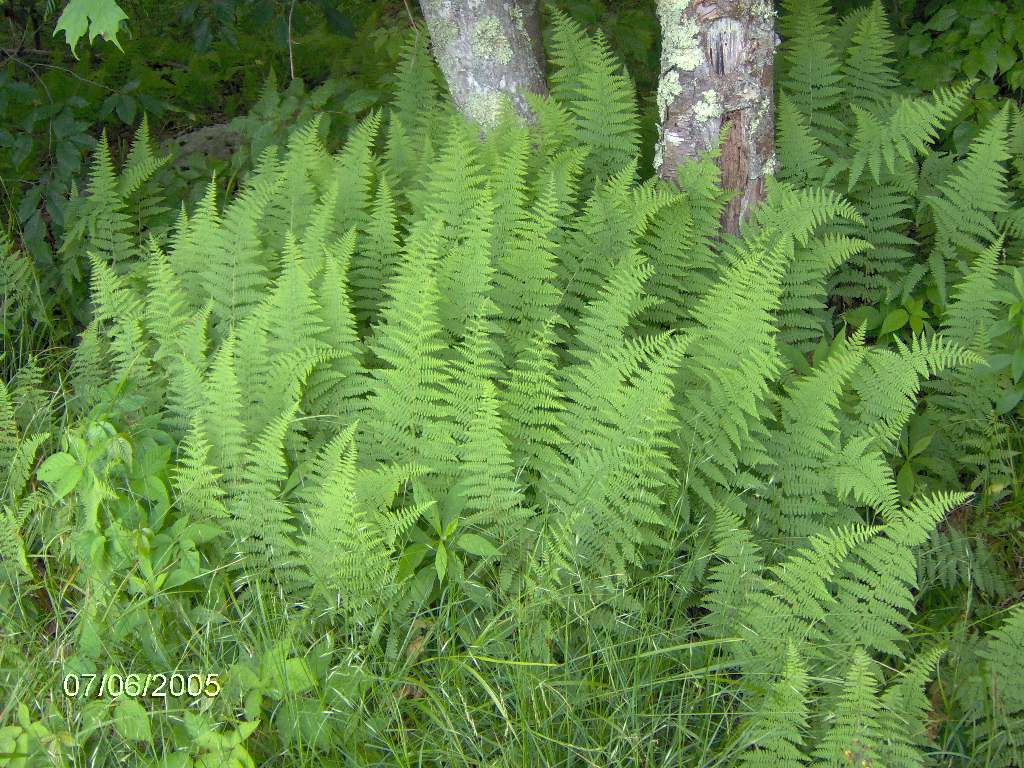Sitobolium punctilobulum
Common Name(s):
Previously known as:
- Dennstaedtia punctiloba
- Phonetic Spelling
- sy-toh-BOH-lee-um punk-tih-LOH-bew-lum
- Description
-
Easy to cultivate. Spreads rapidly in light shade to sun and is fairly drought tolerant. It also tolerates salt spray. Crushed fronds emit the fragrance of freshly mowed hay. Fronds tend to become ragged in late summer.
Develops patches of fronds instead of individual clumps. Long, erect to arching, lance-shaped fronds usually widest at the base and are hairy. Yellow-green fronds are thin textured, bipinnate to binnate-pinnatifid with an oval-oblong shape. Pinna are closely spaced but not exactly opposite. It has an acute tip. Pinnule are opposite. Stipe is one-fourth to one-third the frond length and brown to shinny red in color. Fronds turn soft yellow in fall.
Habitat: Rocky or dry woodlands and forests, rock outcrops, pastures, clearings, road banks
VIDEO Created by NC State Extension's Homegrown series featuring Mark Weathington, Director of JC Raulston Arboretum.
- Profile Video:
- See this plant in the following landscape:
- Cultivars / Varieties:
-
- Tags:


























- Cultivars / Varieties:
-
- Tags:
-
-
Attributes:
- Genus:
- Sitobolium
- Species:
- punctilobulum
- Family:
- Dennstaedtiaceae
- Life Cycle:
- Perennial
- Recommended Propagation Strategy:
- Division
- Country Or Region Of Origin:
- Eastern Canada to U.S.A
- Fire Risk Rating:
- medium flammability
- Particularly Resistant To (Insects/Diseases/Other Problems):
- Deer, drought tolerant, salt spray tolerant, rabbits
- Dimensions:
- Height: 1 ft. 0 in. - 2 ft. 0 in.
- Width: 3 ft. 0 in. - 4 ft. 0 in.
-
-
Whole Plant Traits:
- Plant Type:
- Fern
- Herbaceous Perennial
- Native Plant
- Woody Plant Leaf Characteristics:
- Deciduous
- Habit/Form:
- Arching
- Clumping
- Erect
- Spreading
- Growth Rate:
- Rapid
- Texture:
- Fine
-
-
Cultural Conditions:
- Light:
- Full sun (6 or more hours of direct sunlight a day)
- Partial Shade (Direct sunlight only part of the day, 2-6 hours)
- Soil Texture:
- Clay
- Loam (Silt)
- Sand
- Soil pH:
- Acid (<6.0)
- Neutral (6.0-8.0)
- Soil Drainage:
- Good Drainage
- Moist
- Occasionally Dry
- NC Region:
- Coastal
- Mountains
- Piedmont
- USDA Plant Hardiness Zone:
- 3a, 3b, 4a, 4b, 5a, 5b, 6a, 6b, 7a, 7b, 8a, 8b
-
-
Fruit:
- Fruit Description:
- No fruits. This plants reproduces via spores.
-
-
Flowers:
- Flower Description:
- No flowers.
-
-
Leaves:
- Woody Plant Leaf Characteristics:
- Deciduous
- Leaf Color:
- Green
- Leaf Value To Gardener:
- Fragrant
- Showy
- Deciduous Leaf Fall Color:
- Gold/Yellow
- Leaf Type:
- Compound (Pinnately , Bipinnately, Palmately)
- Fronds
- Leaf Arrangement:
- Opposite
- Leaf Shape:
- Oblong
- Pinnatifid
- Hairs Present:
- Yes
- Leaf Length:
- > 6 inches
- Leaf Description:
- Long, erect to arching, lance-shaped fronds usually widest at base. Also hairy. Yellow-green fronds are thin textured, bipinnate to binnate-pinnatifid with an oval-oblong shape. Pinna are closely spaced but not exactly opposite. Has an acute tip. Pinnule are opposite. Fronds turn soft yellow in fall. Crushed fronds emit a fragrance of fresh mowed hay. Tends to become ragged in late summer.
-
-
Stem:
- Stem Color:
- Green
- Red/Burgundy
- Stem Is Aromatic:
- No
- Stem Form:
- Straight
- Stem Surface:
- Polished
- Stem Description:
- One-fourth to one-third the frond length and brown to shinny red in color.
-
-
Landscape:
- Landscape Location:
- Naturalized Area
- Slope/Bank
- Woodland
- Landscape Theme:
- Cottage Garden
- Native Garden
- Rock Garden
- Design Feature:
- Mass Planting
- Resistance To Challenges:
- Deer
- Drought
- Rabbits
- Salt






